Research Activities
Restoration and Repair Methods
The goal of this project is to provide support for the repair and restoration of architectural cultural assets with regard to the accurate restoration of assets to their original condition via the analysis of data obtained from traditional architecture research studies. The main elements of the project include plans for the restoration of Seyeonjeongji Pavilion and Mireuksa Temple using 3D scan data. Other ongoing research projects include the restoration of ancient buildings such as Hwangnyongsa, Mireuksa and Jeongnimsa Temples, as well as research on heritage resource preservation methods and techniques.
Project to Repair and Restore the Stone Pagoda at Mireuksa Temple Site, Iksan
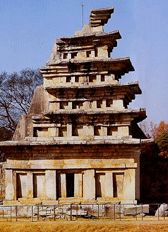
Stone Pagoda at Mireuksa Temple Site, Iksan
In 1998, based on the results of a structural safety inspection, concerns were raised about the deterioration of the structural safety of the tone Pagoda at Mireuksa Temple Site, Iksan, so the decision was made to carry out a “disassemble and restore” process in 1999. Some two years later, in October 2001, the National Research Institute of Cultural Heritage, in conjunction with Jeollabuk-do, carried out the disassembly, repair, and restoration of the stone pagoda. Although scant precise data regarding the pagoda was available before the repair work was carried out, significant data were collected in the process of dismantling and investigation. Studies are being carried out concerning the repair of stone-made cultural heritage objects, along with diverse academic studies in such areas as architecture, archaeology, art history, and preservation science. The dismantling and excavation of the Stone Pagoda at Mireuksa Temple Site, Iksan has been completed. The work for scientific preservation treatment and maintenance is under way, using the original members as much as possible.
Outline
The Stone Pagoda at Mireuksa Temple Site, Iksan was built in the Baekje Period, during the reign of King Mu (600-641). According to Samguk-yusa (Memorabilia of the Three Kingdoms), on the way to Sajasa Temple, King Mu and his queen saw an apparition of the Maitreya triad. They decided to build a temple on the spot, but it happened to be the site of a pond. Monk Jimyeong helped the king to fill up the pond overnight and accomplish their wish. Mireuksa Temple was completed finally with a layout constituting three areas, each containing a Buddha hall named Geumdang (golden hall) and pagoda.
Thought the pagoda is estimated to have been nine stories originally, it was collapsed before the 17th century and now only six stories remained. In 1915 the Japanese roughly reinforced the broken part with concrete and up until 2001 the pagoda had remained in this deformed shape. The stone pagoda at Mireuk Temple Site is known to be the biggest and oldest (judging by style) stone pagoda extant in Korea. The cross shaped corridor on the first story, central interior column, and structure of the ceiling are characteristic features of ancient stone pagodas.
Cording to the results of a structural safety inspection on 1998, The Cultural Properties Committee decided to dismantle and repair the pagoda for its continued conservation. Jeollabuk-do Administration had started scaffolding construction and begum preparing for dismantling from 1999. In November 2001, the National Research Institute of cultural Heritage began removing the concrete and has been safely dismantling and handling and the separate pieces of the pagoda The work of dismantling and the excavation survey was completed by 2010. The project to dismantle and excavate the Three-story Stone Pagoda of Bulguksa Temple was completed in 2010. The pagoda is currently undergoing repair and conservation treatment work.
 Prior to the disassembly of the Stone Pagoda at Mireuksa Temple Site, Iksan
Prior to the disassembly of the Stone Pagoda at Mireuksa Temple Site, Iksan
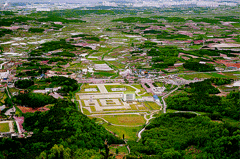 View of the Mireuksa Temple Site, Iksan
View of the Mireuksa Temple Site, Iksan
Disassembly
Repair and Restoration Process of Stone Pagoda at Mireuksa Temple Site, Iksan
According to the results of a structural safety inspection on 1998, The Cultural Properties Committee decided to dismantle and repair the pagoda for its continued conservation. In preparation for the project, a makeshift hut was set up in 1991 on the temple grounds in Jeollabuk-do and, after October 2001, the National Research Institute of Cultural Heritage took over the project, removing the concrete that had been slapped onto the pagoda for reinforcement purposes and conducting a structural analysis of the disassembled pagoda.
 Prior to the disassembly of the stone pagoda (East)
Prior to the disassembly of the stone pagoda (East)
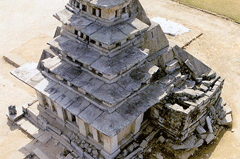 Prior to the disassembly of the stone pagoda (Bird's-eye view)
Prior to the disassembly of the stone pagoda (Bird's-eye view)
Traditional stonemasons had to break the concrete around the stone pagoda that was cast to enforce the structure in 1915 under Japanese rule. This was in order to remove the stone pagoda from the damaged section. The amount of concrete removed from the site as of 2004 was 185 tons.
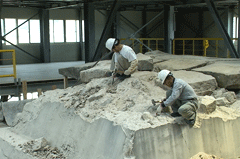 Disassembled concrete (6-stories)
Disassembled concrete (6-stories)
 Disassembled concrete (2-stories)
Disassembled concrete (2-stories)
A professional grappler had to use a 10ton hoist to carry the stone pagoda and the damaged section safely. The dissembling and transfer of a stone pagoda requires years of experience and advanced skills.
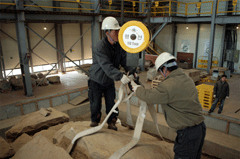 Disassembled stonework
Disassembled stonework
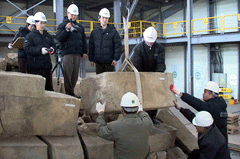 Disassembled stonework
Disassembled stonework
As the stonework was dismantled, the first base of the stone pagoda, and the inner foundation stone, were exposed. From the disassembly of the southwestern section of the stonework it appeared that the newly-found stone statue was in excellent condition, with almost no damage to the face and body. It is assumed that the stone statue was built prior to the stone pagoda.
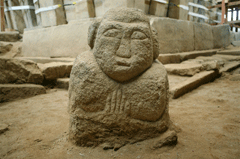 Excavation of stone statue from southwestern part
Excavation of stone statue from southwestern part
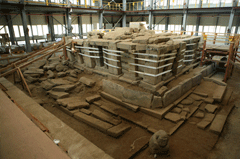 Reinforcement prior to dismantling of first story
Reinforcement prior to dismantling of first story
The stone pagoda’s first base level and inner foundation stone were tilted and displaced, making it imperative to disassemble the structure in order to carry out safe repair and restoration work. In January 2009, during the creation of the cruciform passage, many well-preserved artifacts such as the Sari Urn, which was buried during the reign of King Muwang of Baekje, were excavated.
 Construction of cruciform passage prior to dismantling
Construction of cruciform passage prior to dismantling
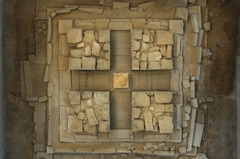 Comprehensive plan of the cruciform passage
Comprehensive plan of the cruciform passage
Measurement
Repair and Restoration Process of Stone Pagoda at Mireuksa Temple Site, Iksan
Before disassembly, the shape of each piece is precisely surveyed with a digital measuring device and the information is recorded as electronic data (three-dimensioned data). Also, in the case of pieces that unavoidably end up in a different position after repair, the difference in position is measured and recorded in order to produce records for comparison and evaluation of the pagoda before and after the restoration project.
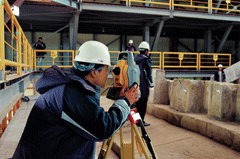 Location of damaged section before dissembling
Location of damaged section before dissembling
 Survey key map
Survey key map
The configuration and elevation of all pieces of the pagoda are recorded along with photographs and plans. The survey records of each piece are used to analyze construction techniques and condition and are also used as data for repair and restoration of the pieces.
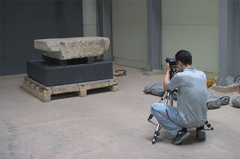 Photo shoot of damaged section after dissembling
Photo shoot of damaged section after dissembling
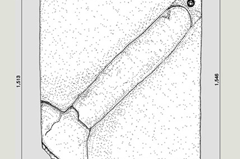 Gwiokgaeseok Stone CAD blueprint
Gwiokgaeseok Stone CAD blueprint
Measuring points recorded with a digital theodolite Benchmarking scheme Digital solids of all the pieces and their shapes as they appear in the process of dismantling are produced with 3D scanning. Motion simulation and modeling data are produced from the 3D solids to provide basic materials for academic research and structural analysis of the pagoda, as well as investigation of reasons for its collapse.
 3D Scan's Statue
3D Scan's Statue
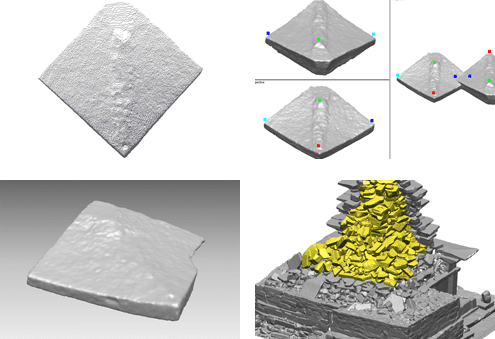 3D Scan
3D Scan
Excavation
The Stone Pagoda at Mireuksa Temple Site, Iksan was built in the Baekje Period, during the reign of King Mu (600-641). According to Samguk-yusa (Memorabilia of the Three Kingdoms), on the way to Sajasa Temple, King Mu and his queen saw an apparition of the Maitreya triad. They decided to build a temple on the spot, but it happened to be the site of a pond. Monk Jimyeong helped the king to fill up the pond overnight and accomplish their wish. Mireuksa Temple was completed finally with a layout constituting three areas, each containing a Buddha hall named Geumdang (golden hall) and pagoda.
Thought the pagoda is estimated to have been nine stories originally, it was collapsed before the 17th century and now only six stories remained. In 1915 the Japanese roughly reinforced the broken part with concrete and up until 2001 the pagoda had remained in this deformed shape. The stone pagoda at Mireuk Temple Site is known to be the biggest and oldest (judging by style) stone pagoda extant in Korea. The cross shaped corridor on the first story, central interior column, and structure of the ceiling are characteristic features of ancient stone pagodas.
Cording to the results of a structural safety inspection on 1998, The Cultural Properties Committee decided to dismantle and repair the pagoda for its continued conservation. Jeollabuk-do Administration had started scaffolding construction and begum preparing for dismantling from 1999. In November 2001, the National Research Institute of cultural Heritage began removing the concrete and has been safely dismantling and handling and the separate pieces of the pagoda The work of dismantling and the excavation survey was completed by 2010. At present, the work of preservation treatment, repair, and maintenance is under way.
 A view of the inside of the search trench outside the western side of the base
A view of the inside of the search trench outside the western side of the base
 A view of the site after completion of the dismantlement and excavation of the stone pagoda
A view of the site after completion of the dismantlement and excavation of the stone pagoda
Conservation Treatment
Repair and Restoration Process of Stone Pagoda at Mireuksa Temple Site, Iksan
Based on the characteristics of the stone used to construct the stone pagoda, the quarry site, the biological organism colonization and removal trial, and the evaluation of surface pollutants and removal trial, conservation treatment plans were formulated and future conservation management measures established.
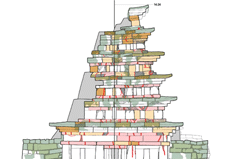 Conservation science comprehensive view of damage
Conservation science comprehensive view of damage
 Conservation environment management measures
Conservation environment management measures
The conversation treatment procedure for a section of damaged stone is as follows: cleansing – application of adhesive – application of filler – reinforcement – application of water repellent treatment – color correction. The removal of pollutants is conducted based on the type and degree of damage: both wet and dry methods may be used to reduce the risk of damage.
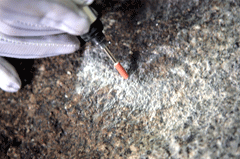 Removal of surface pollutants
Removal of surface pollutants
 Insertion of metal reinforcement
Insertion of metal reinforcement
To reinforce the damaged section, stainless steel, titanium, copper, or resin mortar pins are inserted, based on the condition and reusable parts of the stone.
Damaged fragments are glued together using epoxy resin, which is also inserted as filler into cracks.
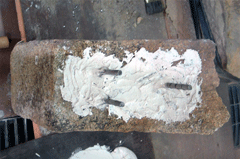 Epoxy resin on the adhesive surface
Epoxy resin on the adhesive surface
 Epoxy resin syringe
Epoxy resin syringe
The color is carefully restored with acrylic paint after processing the surface ith mineral materials. Apply one to three layers of water repellent depending on the stone's condition.
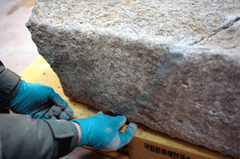 Surface conditioning of the glued area
Surface conditioning of the glued area
 Resin implant processing
Resin implant processing
For parts requiring the restoration of their original shape and form, new stone is processed and added to the damaged section. Various tools are used to match the surface of the newly-processed stone to that of the original, weathered surface.
 Manufacture implant area stone material
Manufacture implant area stone material
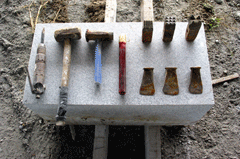 Stone processing tools
Stone processing tools
Sarira Requaries control research
Repair and Restoration Process of Stone Pagoda at Mireuksa Temple Site, Iksan
In the process of dismantling the stone pagoda, 684 artifacts classified into 19 categories at the level of National Treasures, including an urn containing ‘sari’ (Sacred relics of a Buddha), were discovered in a square-shaped case in the center of the first level stone (25cm long x 27cm deep). Among the excavated artifacts, the sarira requary was confirmed to consist of three ‘layers’, i.e., an outer urn, an inner urn, and a glass bottle. An examination of the inscription ‘Geumjesaribongyeonggi’ (“Respectful welcome of a golden urn”) revealed that the stone pagoda was constructed in the “Gihaenyeon” year (639 A.D.).
 View prior to excavation of the Sari Urn
View prior to excavation of the Sari Urn
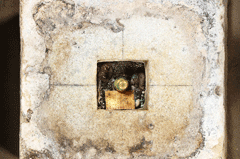 Opening and cylindrical central pole of the stone pagoda (Jan. 14, 2009)
Opening and cylindrical central pole of the stone pagoda (Jan. 14, 2009)
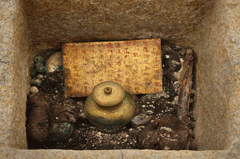 Initial condition of the Sari Urn
Initial condition of the Sari Urn
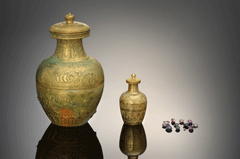 Gilt bronze outer, inner urn, and sacred relics
Gilt bronze outer, inner urn, and sacred relics
 Geumjesaribongyeonggi (Front)
Geumjesaribongyeonggi (Front)
 GiGold plate, gilt bronze tweezers
GiGold plate, gilt bronze tweezers
 Silver diadem ornament
Silver diadem ornament
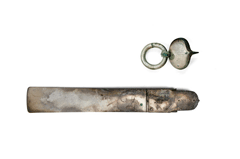 Large silver ornament
Large silver ornament
 Bronze bowl
Bronze bowl
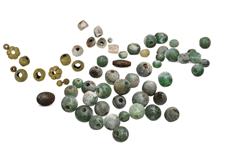 Glass beads and various beads
Glass beads and various beads
 Glass panel
Glass panel
Progress
| Period | Content |
|---|---|
| December 1997 ~ December 1998 |
Decision made to disassemble and restore the stone pagoda after a safety review of the stone pagoda structure by the Cultural Heritage Committee. |
| January 2000 ~ October 2001 |
Preparatory construction work for the disassembly of the stone pagoda, organization of a project team, and installation of wooden scaffolding beams. |
| October 31, 2001 | Signing of a contract with the agency appointed to do the work, and performance of a ritual before logging trees. |
| Novemver 2001 | Commencement of an investigation of the climate and environment surrounding the stone pagoda (ongoing). |
| January 2002 ~ December 2002 |
- Disassembly and investigation of the 6th-3rd stories of the stone pagoda.
- Construction of temporary protective fences and office facilities - Formation of an advisory committee for the restoration of the Stone Pagoda at Mireuksa Temple Site, Iksan. |
| December 1997 ~ December 1998 |
- Disassembly and investigation of the 2nd story of the stone pagoda.
- Publication of Report I on the disassembly and investigation of the stone pagoda. - Construction of outdoor facilities for loading structures. - Onsite investigations of restoration cases of overseas stone cultural heritages (including Angkor Watt, Cambodia). - Investigation of the characteristics of the stone pagoda’s rocks, and survey of areas from which stone was supplied. - Investigation of the state of degradation of the Stone Pagoda at Mireuksa Temple Site, Iksan, and research on preservation agents. |
| January 2004 ~ December 2004 |
- Detailed investigation of the 1st story of the stone pagoda.
- Publication of Report II on the disassembly and investigation of the stone pagoda. - Completion of the disassembly of the concrete structure of the stone pagoda (185 tons). - Seminar held to report the results of investigations and disassembly of the Stone Pagoda, Mireuksa Temple Site, Iksan. - Onsite investigation of restoration cases of overseas stone cultural heritages (Including Borobudur, Indonesia). - Analysis of the substance and strength of the concrete structure of the stone pagoda. - Jan. 2005~Dec. 2005: Contaminants on the surface of the stone pagoda investigation & Research - Investigation of the possibility of processing the structure of the stone pagoda. |
| December 16, 2004 |
- Inspected the disassembly of the 1st story of the stone pagoda.
- Published the Disassembly Investigation Report III. - Analyzed the substance and strength of Stone Pagoda at Mireuksa Temple Site, Iksan. - Removed makeshift cover and scaffold. - Investigated the cause of the collapse of Stone Pagoda at Mireuksa Temple Site, Iksan through the analysis of structures. - Conducted onsite investigations of stone cultural heritage located overseas (Greece, Italy). - Held a symposium on the disassembly and restoration of Stone Pagoda at Mireuksa Temple Site, Iksan. |
| January 2006 ~ December 2006 |
- Inspection of the disassembly and stonework of the 1st story of the stone pagoda. - Investigation of the physiochemical weathering of the structure of the stone pagoda. |
| January 2007 ~December 2007 |
- Inspection of the disassembly and stonework of the 1st story of the stone pagoda.
- Inspection of the strengthening treatment of the weathered structure. - Research and evaluations of the safety of the structure of Stone Pagoda, Mireuksa Temple Site, Iksan. |
| January 2008 ~December 2008 |
- Completion of the disassembly of the stone structure, and investigation of the disassembly of the 1st story of the stone pagoda.
- Completion of research and evaluations of the Stone Pagoda, Mireuksa Temple Site, Iksan. - Composition analysis of the stone pagoda. - Excavation and investigation of stone statutes. - Investigation of the condition of sites near the Mireuksa Temple Site, Iksan. - Onsite seminar held. - Planning of the basic restoration of the Stone Pagoda at Mireuksa Temple Site, Iksan, and construction of a model. - Preservation of the damaged structure of the Stone Pagoda, Mireuksa Temple Site, Iksan. |
| January 2009 ~December 2009 |
- Investigation of the collection of Sarira Reliquaries (684 items in 19 categories including Sarira Urns).
- Press conference on Sarira Reliquaries. - Investigation of the disassembly of the 1st story and foundation structure of the stone pagoda. - Investigation of the structural performance of strengthening materials. - Strengthening and restoration of the damaged structure. - Special exhibition of Sarira Reliquaries. - Measurement of the displacement of the 1st story of the stone pagoda; precision investigation. - Workshop on measures for strengthening the structure of the Stone Pagoda of the Mireuksa Temple Site, Iksan. - Excavation of the foundation structure of the stone pagoda. |
| January 2010 ~December 2010 |
- Investigation if the cornerstone and disassembly of the 1st story of the stone pagoda.
- Excavation of the foundation structure of the stone pagoda. - Design of the basic restoration of the stone pagoda. - Survey of the structure, and restoration of the damaged structure (Ongoing). - Publication of Report Ⅳ on the disassembly and investigation of the Stone Pagoda at Mireuksa Temple Site, Iksan. - International academic symposium held on the Stone Pagoda at Mireuksa Temple Site, Iksan, a treasure of Baekje Buddhist culture. |
| January 2011 ~December 2011 |
- Design and planning of the restoration of the Stone Pagoda, Mireuksa Temple Site, Iksan.
- Production of a detailed model of the stone pagoda using 3D data. - Experimental research on measures for strengthening the soil layer of the foundation structure of the pagoda stone. - Survey of excavated heritage items including Sarira Reliquaries. - Survey of the assembled structure and foundation of the stone pagoda. - Restoration of the damaged structure of the foundation structure and the 1st story of the stone pagoda. - International forum on the restoration of the Stone Pagoda, Mireuksa Temple Site, Iksan. - Seminar for residents living near the Stone Pagoda, Mireuksa Temple Site, Iksan. - Publication of report Ⅳ on the disassembly and investigation of the Stone Pagoda at Mireuksa Temple Site, Iksan. |
| January 2013 ~December 2013 |
- Repair and maintenance work of the Stone Pagoda at Mireuksa Temple Site, Iksan
- Preservation treatment of damaged members (on the first and second tiers) of the stone pagoda - Experiment/research concerning how to reinforce the foundation soil layer of the pagoda - Patent application for repair techniques for stone-made cultural heritage objects - Joint hosting of a special exhibition of sarira reliquary; publication of a catalog - Maintenance and repair work on facilities, including replacement of fences, etc. |
| January 2014 ~December 2014 |
- Completion of the rammed earth foundation of the pagoda and examination of the maximum possible bearing capacity. - Construction of the stonemason and blacksmith’s workshop, processing of new materials, and daily supervision. - Establishment of an inspection team composed of experts in architecture, structures, civil engineering, preservation and masonry, and execution of onsite inspections. - Conservation treatment for damaged materials, computerization of historical records, and research on metal reinforcements. - Registration of patents on repair techniques for stone heritages (reinforcement of foundations and stone-metal items) - Publication of a comprehensive report titled Reliquary Decoration of Mireuksa Temple Site. |
Research on Restoration and Maintenance of Mireuksa Temple
As a result of the 17-year-long excavation survey of the Mireuksa Temple Site in Iksan (Historic Site), following the survey of the site of the east pagoda in 1974, it was concluded that the temple was the largest one ever built during the Baekje Period. The temple has a unique layout of buildings. There are three Geumdang Halls and three pagodas, each of which is separated with roofed corridors. They are divided into the Eastern Section, Middle Section, and Western Section. We plan to restore the temple based on restoration and archaeological verification research as part of the plan for the preservation of the ancient royal capital of Baekje and to register it as World Cultural Heritage.
See details
Purpose of research
- To establish an maintenance plan with the Mireuksa Temple Site’s features and surroundings taken into consideration
- To conduct restoration/archaeological verification research on major building sites with a view to their systematic restoration and maintenance
- Research on how to develop the area into a historical/cultural site and how to link it with nearby areas
Major development (2013)
- Analysis of the status of the site and basic research on how to maintain it
- Survey of the drainage system and water channels within the site
- Research on how to improve information panels and the visitors’ path
Major promotional plan (2014)
- Designation of the scope of maintenance of major parts of the site and the relevant methods
- Research on skills and materials to be used for maintenance
- Basic plan for the improvement of protective and public facilities
- Basic restoration/archaeological verification research (layout and demarcation; foundation and stone embankment)
Restoration of the Gyeongju Stone Pagodas About the Gyeongju Stone Pagodas and the Project Outline
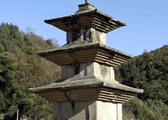
In accordance with the repair plan established by the Cultural Heritage Committee, based on the results of a precision safety diagnosis conducted in 2001, the National Research Institute of Cultural Heritage has been carrying out repairs on the East and West Three-story Stone Pagodas at Gameunsa Temple Site, Gyeongju Dabotap Pagoda of Bulguksa Temple, Gyeongju, since May 2003, applying also various treatments for long-term preservation of these stone structures.
Cracks were detected in the roof stone of the upper platform of the Three-story Stone Pagoda of Bulguksa Temple in Gyeongju in December 2010. Repair work is currently being carried out by the Gyeongju Stone Heritage Restoration Service.
Preliminary Survey and Record of Present Conditions
Preliminary Survey and Record of Present Conditions of Stone Pagodas
1. Survey of Structural Methods
Surveys have been conducted on the methods of constructing stone pagodas and on the size and location of extant structures. Measurement data are analyzed and used as fundamental data for restoration.
 Structural Techniques
Structural Techniques
2. 3-Dimensional Configuration Records
We have performed 3-dimensional scanning in order to secure records and basic data for the preservation management of pre-maintenance stone pagodas. Through this 3-dimensional scanning, structural analysis of the present conditions - using techniques such as video, precise measurement, mapping and interpretation - can be conducted, and the conditions of artificial and natural damage can be expressed through simulations.
 3D data for the Three-story Stone Pagoda at the Gameunsa Temple Site, Gyeongju
3D data for the Three-story Stone Pagoda at the Gameunsa Temple Site, Gyeongju
 Data on the 3rd story roof-stone of the Three-story Stone Pagoda at the Gameunsa Temple Site, Gyeongju
Data on the 3rd story roof-stone of the Three-story Stone Pagoda at the Gameunsa Temple Site, Gyeongju
3. Weather Damage Survey
In order to assess the severity of damage to individual pagodas and formulate future preser-vation management plans, we have created weathering diagrams based on onsite surveys and experimental studies. The weathering diagrams are divided into four principal categories (i.e., surface weathering, surface pollution, biological damage, and repair materials), which are then further divided into sub-categories. Photographic and 3D diagrams have allowed us to determine the overlap between these categories with increasing accuracy. In particular, the analysis of SEM/EDX and ion levels related to surface pollution and biological damage has been used to provide fundamental data for the removal of surface pollutants.
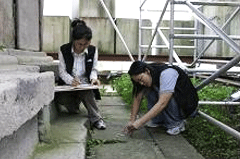 Weather Damage Survey
Weather Damage Survey
 Weathering Diagram of the North Side of the Three-story Stone Pagoda at Gameunsa Temple Site, Gyeongju
Weathering Diagram of the North Side of the Three-story Stone Pagoda at Gameunsa Temple Site, Gyeongju
Research on repair and maintenance measures
1. Water Leakage Prevention Research
The East and West Three-story Stone Pagodas at Gameunsa Temple Site, Gyeongju are affected by water leakage, occurring along the joints where roofstone sections meet. Water leakage is affecting also Dabotap of Bulguksa Temple, Gyeongju, in spite of the drainage present along the square parapet encircling the pagoda. We investigated the functionality of the drainage, the causes of water leakage and the damage to the condition of the building stone, and studied action plans to repair leaks and prevent water damage, in order to determine a disassembly and repair methodology.
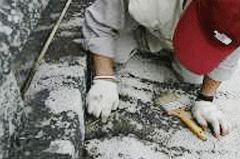 Cleaning Dabotap Pagoda waterway at Bulguksa Temple, Gyeongju
Cleaning Dabotap Pagoda waterway at Bulguksa Temple, Gyeongju
2. Tenon Restoration Research
Tenons are an important structural component for joining two pieces of wood or stone. Some of the tenons of the three-story stone pagoda in the Gameunsa Temple Site have been lost during a repair. For reconstruction of the pagoda, we surveyed the wedge grooves and analyzed the wedge size and composition in order to make experimental models, as well as studying the connection methods used for the wedges. The results of this study have been reflected in the maintenance work.
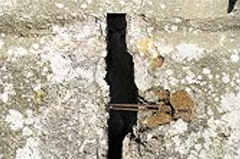 Photos of the joints between the roofstone sections taken prior to the disassembly of the pagoda
Photos of the joints between the roofstone sections taken prior to the disassembly of the pagoda
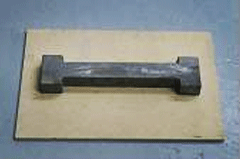 A model tenon replicating the original tenon
A model tenon replicating the original tenon
3. Repair Strategy Research
Structural risk was recently identified in the West Three-story Stone Pagodas at Gameunsa Temple Site, Gyeongju, whose parts had become extensively displaced, creating gaps. The pagoda was disassembled from its pinnacle to the support stone to the topmost roofstone. The ten disassembled pieces are currently being studied by researchers of the National Research Institute of Cultural Heritage to determine the best restoration strategy. Their joints are examined, and structural calculation is performed through the analysis of the central axis.
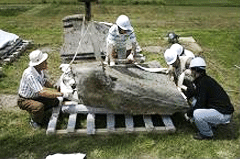 Dissembling Three-story Stone Pagoda (West) at Gameunsaji, Gyeongju
Dissembling Three-story Stone Pagoda (West) at Gameunsaji, Gyeongju
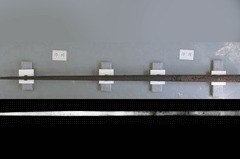 Gamma-ray imaging of the pinnacle of the Western Three-story Pagoda in the Gameunsa Temple Site, Gyeongju
Gamma-ray imaging of the pinnacle of the Western Three-story Pagoda in the Gameunsa Temple Site, Gyeongju
4. Conservation Treatment Research
A variety of conservation agents are being used on aging stone structures, ranging from reinforcing agents to improve the resistance of weathered stone components to binding agents applied to adjoining parts that have separated from each other and fillers for plugging holes created from erosion.
As the use and effect of this agent varies depending on the type of stone and the degree of weathering sustained, we have engaged in experimental studies on individual towers to select the most effective restorative agent.
 Inserting fillers into holes and gaps
Inserting fillers into holes and gaps
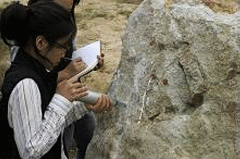 Strength testing of stone parts
Strength testing of stone parts
5. Research on stone types for replacement parts
To provide scientific information on the properties of stones used for the construction of historical pagodas and assist restoration specialists with the selection of stones for fabrication of replacement parts, the National Research Institute of Cultural Heritage measures their whole rock magnetic susceptibility rate and performs gamma spectrometer analysis. The type of stone used for the construction of the East and West Three-story Pagodas of the Gameunsa Temple Site , Gyeongju was determined precisely through these procedures. Stones of an identical variety were quarried from a nearby site, for use in the restoration of the two pagodas.
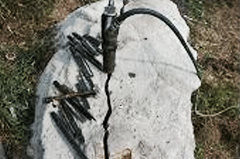 Quarry
Quarry
Cultural Property Conservation Treatment
Conservation Treatment of Stone Structures
1. Removal of Surface Pollution Buildups
The leakage at the waterway seams at three-tier stone pagoda Okgaeseok on west and east Gameunsaji are causing the soil to escape and corroding the stone pagoda’s surface. The damage is furthered by winds. There are waterways following the handrails that surround Dabotap Pagoda but foreign objects and weathered waterway is causing the seams to leak. We investigated the functionality of the drainage, the causes of water leakage and the damage to the condition of the building stone, and studied action plans to repair leaks and prevent water damage, in order to determine a disassembly and repair methodology.
 Low-pressure vortex stream cleaning
Low-pressure vortex stream cleaning
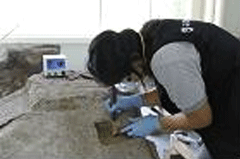 Low-pressure vortex stream cleaning
Low-pressure vortex stream cleaning
2. Emergency Conservation Treatment
During a recent repair and maintenance of the West Three-story Stone Pagodas at Gameunsa Temple Site, Gyeongju structural instability was detected in the eastern pagoda of the same temple site. Its upper base stone and second-level body stone were about to get detached from the rest of the structure. These sections were given an emergency conservation treatment by our team of conservation scientists. A similar emergency intervention has been made to the three-story pagoda of Bulguksa Temple, a portion of whose finial was breaking off.
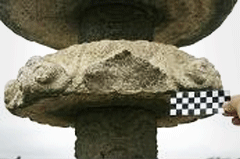 Three-story stone pagoda of Bulguksa Temple before the conservation treatment on the finial
Three-story stone pagoda of Bulguksa Temple before the conservation treatment on the finial
 Conservation treatment administered to the finial of the three-story stone pagoda of Bulguksa Temple
Conservation treatment administered to the finial of the three-story stone pagoda of Bulguksa Temple
 Three-story stone pagoda of Bulguksa Temple after the conservation treatment on the finial
Three-story stone pagoda of Bulguksa Temple after the conservation treatment on the finial
3. Treatment Recordkeeping
All treatments dispensed for conservation of a cultural heritage structure and building are recorded in detail to eliminate repeat errors in the choice of a treatment regime. The treatment logs, planned to be used for compilation of a conservation treatment manual, are also aimed at facilitating future monitoring activities by providing a complete history of treatments.
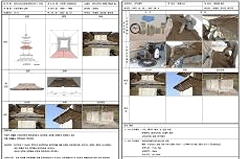 Conservation treatment record card for the West Three-story Stone Pagodas at Gameunsa Temple Site, Gyeongju
Conservation treatment record card for the West Three-story Stone Pagodas at Gameunsa Temple Site, Gyeongju
4. Weather Monitoring
To gather atmospheric environment data of the Gameunsa Temple Site and Bulguksa Temple, the National Research Institute of Cultural Heritage set up an automatic weather station in both sites, in 2004 and 2006. In Bulguksa, to monitor microenvironmental deviations, an anemo-meter was installed near Seokgatap, and a thermometer and a hygrometer inside Dabotap.
 Weather station in the Gameunsa Temple Site (DGB-106)
Weather station in the Gameunsa Temple Site (DGB-106)
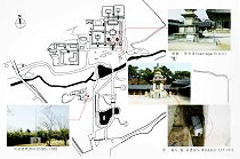 Weather station within the precincts of Bulguksa Temple
Weather station within the precincts of Bulguksa Temple
Structural Safety Inspection and Monitoring of Stone Pagodas
1. Structural Safety Inspection and Monitoring of Stone Pagodas
Our conservation science team uses electro-optical distance measuring instruments and crack meters to determine the progress of deterioration of stone pagodas, including displacement, splitting, gaping and damage to stone itself. Stone pagodas are regularly inspected for their integrity to take speedy dispositions upon discovery of signs of deterioration.
 Safety check performed on the three-story pagoda of the Gameunsa Temple Site
Safety check performed on the three-story pagoda of the Gameunsa Temple Site
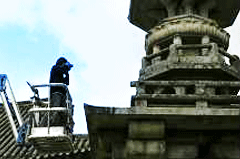 Safety check performed on Dabotap Pagoda of Bulguksa Temple, Gyeongju
Safety check performed on Dabotap Pagoda of Bulguksa Temple, Gyeongju
2. Continuous Measurement System
Structural distortion started to occur to the three-story stone pagoda of Bulguksa Temple, with its lower base twisted and separated from the rest of the edifice, due to the inner foundation becoming hollow. The pagoda is currently being monitored for structural movements, using a continuous measurement system. The data gathered from this system will be used to determine the precise time-frame for a repair.
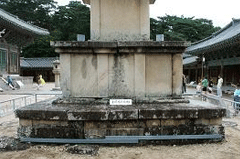 Continuous measurement system installed at the three-story stone pagoda of Bulguksa Temple
Continuous measurement system installed at the three-story stone pagoda of Bulguksa Temple
3. Structural interpretation through the analysis of the central axis
The structural interpretation of the stone pagoda based on the results of analysis of the central axis is crucial for preventing breakage and splitting caused by structural transformation. Using 3D structural interpretation techniques, our conservation experts work on identifying root causes to structural changes so as to develop a coherent and effective reinforcement strategy to be used during the restoration of the three-story pagoda.

 3D modeling of the support stone to the topmost roofstone
3D modeling of the support stone to the topmost roofstone
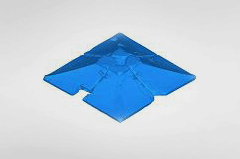 3D modeling of the topmost roofstone
3D modeling of the topmost roofstone
Progress
| Period | Content |
|---|---|
| March 2003 | Signing of an agreement with Gyeongju-si for execution of the project. |
| April 2003 | Formation of a project team for the restoration of the Gyeongju Stone Pagoda. |
| December 10, 2003 | 1st advisory meeting |
| January 2004 ~ Present |
Operation of an automatic weather station for scientific preservation of the East and West Three-story Stone Pagodas of the Gameunsa Temple Site. |
| June 15, 2004 | 2nd advisory meeting. |
| July 09, 2004 | Formation of the 1st small committee. |
| July 2004 ~ November 2004 |
3D scanning of the West Three-story Stone Pagoda of the Gameunsa Temple Site. |
| August 2004 ~ March 2005 |
Creation of a map plotting the damage to the West Three-story Stone Pagoda, Gameunsa Temple Site. |
| Sepember 09, 2004 | 1st cultural heritage small committee meeting |
| Sepember 2004 | Selection of the method and scope of preservation of the Three-story Stone Pagoda at Bulguksa Temple. |
| December 2004 | Formation of the 3rd advisory committee. |
| January 2005 |
- Publication of a report on measures for conserving important stone cultural heritages.
- Presentation meeting related to the project to restore the Gyeongju Stone Pagoda. |
| February ~ April 2005 |
Research on temporary strengthening agents. |
| March 2005 | Program related to the installation of an automatic weather observation station within Bulguksa Temple. |
| March 09, 2005 | Provision of advice on the testing of temporary strengthening agents. |
| May 16, 2005 | 1st advisory committee meeting on the permanent measurement system to be installed in the Three-story Stone Pagoda of Bulguksa Temple. |
| June ~ October 2005 |
Investigation of contaminants on the West Three-story Stone Pagoda of the Gameunsa Temple Site, and research on cleansing methods. |
| June 2005 | Emergency restoration of the East Three-story Stone Pagoda of the Gameunsa Temple Site. |
| July 07, 2005 | Research commenced on new stone materials and strengthening agents for the Three-story Stone Pagoda of the Gameunsa Temple Site. |
| July 20, 2005 | 2nd advisory committee meeting on the permanent measurement system to be installed in the Three-story Stone Pagoda of BulguksaTemple |
| August 25, 2005 | Decision taken to install a permanent measurement system in the Three-story Stone Pagoda of Bulguksa Temple. |
| August 2005 | Research commenced on the atmospheric environment surrounding the stone pagoda under restoration. |
| September ~ November 2005 |
Installation of scaffolding for investigation and a steel structure for disassembly of the West Three-story Stone Pagoda of the Gameunsa Temple Site. |
| December 03, 2005 | Onsite investigation and provision of advice by the Cultural Heritage Committee regarding the proposed onsite changes at the Gameunsa Temple Site. |
| January 2006 | Installation of a material processing station and construction of a temporary access road within the Gameunsa Temple Site. |
| february 2006 | Construction of a temporary parking lot at the Gameunsa Temple Site. |
| March 2006 | Construction of a temporary access road for visitors to the Gameunsa Temple Site. |
| April 12, 2006 | Representation meeting on the disassembly of the West Three-story Stone Pagoda of the Gameunsa Temple Site. |
| May 12, 2006 | Formation of an advisory committee related to the disassembly of the West Three-story Stone Pagoda of the Gameunsa Temple Site. |
| June 2006 |
- Distribution of a report on the West Three-story Stone Pagoda of the Gameunsa Temple Site.
- Disassembly the West Three-story Stone Pagoda of the Gameunsa Temple Site. |
| August 18, 2006 | Formation of an advisory committee related to the conservation of disassembled materials of the West Three-story Stone Pagoda of the Gameunsa Temple Site. |
| October 20, 2006 | Formation of an advisory committee on a method of preserving the column which forms the core of the pagoda. |
| November 16, 2006 ~ November 17, 2006 |
Meeting held with people in charge of the repair construction of the stone pagoda. |
| December 2006 | 3D scanning of the West Three-story Stone Pagoda of the Gameunsa Temple Site. |
| March ~ August 2007 |
Formation of a research team for investigation of the structural safety of the West Three-story Stone Pagoda of the Gameunsa Temple Site. |
| March 2007 | Quarrying and production of stone materials for use in the restoration of the East and West Three-story Stone Pagodas of the Gameunsa Temple Site. |
| June ~ Sepember 2007 |
3D scanning of the East Three-story Stone Pagoda of the Gameunsa Temple Site. |
| August ~ December 2007 |
3D scanning of the Three-story Stone Pagoda and the Dabotap Pagoda of Bulguksa Temple, Gyeongju |
| Sepember 2007 | Report by the Cultural Heritage Committee on the restoration proposal for the East and West Three-story Stone Pagodas of the Gameunsa Temple Site. |
| February 2008 | Restoration of the West Three-story Stone Pagodas of the Gameunsa Temple Site. |
| May ~ November 2008 |
Laying of a flat stone on top of the foundation and a tapgu to preserve the East Three-story Stone Pagoda of the Gameunsa Temple Site. |
| October 2008 | Removal of the onsite office from the Gameunsa Temple Site. |
| November 2008 | Installation of temporary scaffolding for the Dabotap Pagoda of Bulguksa Temple, Gyeongju. |
| December 2008 | Presentation meeting on the start of the repair work on the Dabotap Pagoda of Bulguksa Temple, Gyeongju. |
| December 2008 | Formation of a research team for analysis of the data collected from the permanent monitoring system of the Three-story Stone Pagoda of Bulguksa Temple. |
| January ~ February 2009 |
Creation of a map plotting the weathered surface of the Dabotap Pagoda of Bulguksa Temple, Gyeongju. |
| March 2009 | Advisory meeting on the project to restore the Stone Pagoda of Bulguksa Temple; progress reported by the Cultural Heritage Committee. |
| April ~ June 2009 |
Disassembly of the parapet and topmost part of the Dabotap Pagoda of Bulguksa Temple, Gyeongju. |
| July 2009 | Research on the stone materials to be used as the new stone structure of the Dabotap Pagoda of Bulguksa Temple, Gyeongju. |
| August ~ November 2009 |
Assembly and restoration of the disassembled materials. |
| December 2009 | Presentation meeting on the completion of the restoration of the Dabotap Pagoda of Bulguksa Temple, Gyeongju. |
| August 2010 | Completion of the project. |
| December 2010 | Cracks were detected in the roof stone of the upper platform of the Three-story Stone Pagoda of Bulguksa Temple in Gyeongju. |
| June 2010 | Launch of the Gyeongju Stone Heritage Restoration Service |
| February 2012 | Analysis of the cause of the crack formed in the Three-story Stone Pagoda of Bulguksa Temple |
| September 2012 | A session for reporting on the commencement of the progress of the dismantlement and repair of the Three-story Stone Pagoda |
| April 2013 | Collection of sariras and reliquaries from the Three-story Stone Pagoda |
| July 2013 | Discovery of a gilt-bronze standing Buddha among the foundations of the Three-story Stone Pagoda |
| January 2014 | Dismantlement of the Three-story Stone Pagoda of Bulguksa Temple |
| January 2014 | Dismantlement of the Three-story Stone Pagoda of Bulguksa Temple |
| November 2014 | Commencement of reassembly of the Three-story Stone Pagoda of Bulguksa Temple |
Master Plan for the Restoration of Hwangnyongsa Temple

This academic conference was held for the purpose of providing a venue at which foreign and domestic scholars and experts in the maintenance of heritage sites can meet together to engage in public debates. In this way, we hope to create a base for promoting the work on the restoration of Hwangnyongsa Temple, with the creation of a master plan as a guiding initiative.
See details
Outline
Hwangnyongsa Temple is mentioned in major ancient historical chronicles such as Samguk sagi (History of the Three Kingdoms) and Memorabilia of the Samguk yusa (Memorabilia of the Three Kingdoms). The temple was originally meant to be a palace. During the construction of what was to become a palace in the eastern section of Wolseong in Gyeongju, in the 14th year of the reign of King Jinheung (553), it was reported that a yellow dragon had appeared at the site. Upon hearing this report, the Silla king ordered that the edifice under construction be turned into a Buddhist temple rather than a palace. The temple was completed in the 30th year of the reign of King Jinheung (569). Five years after its completion, a gigantic Buddha statue over 3m high was cast, and a separate sanctuary (Geumdang) was built in the 6th year of the reign of King Jinpyeong's reign (584) to house it. In the 12th year of Queen Seondeok's reign (643), a nine-story wooden pagoda was erected on the advice of a monk named Jajang to pray for Silla's success in deterring incursions by Japanese pirates. Similarly, Hwangnyongsa Temple was a large temple built over a lengthy period of 93 years, and which was then repaired and rebuilt several times over, surviving until the Goryeo period. However, in the 25th year of the reign of King Gojong of Goryeo, it was completely destroyed during a Mongol invasion, so today only the site remains. The wide, bare site of Hwangnyongsa Temple remains, but an 8-year-long excavation survey conducted from 1976 revealed the full scale of the magnificent temple built in the Silla period. The more than 40,000 artifacts unearthed from the site becameinvaluable materials for the study of that period. Thanks to the results of this excavation, the Hwangnyongsa Temple was registered as part of the Gyeongju Historic Area, which was itself registered as a World Heritage Site in December 2000.
The Hwangnyongsa Temple Area was purchased as part of the Gyeongju Tourism Comprehensive Development Plan, which enabled extensive excavation surveys and historic site maintenance to be conducted there. The historic site maintenance team, using the results of the excavation as the basis of its work, arranged and embanked the foundation stones and planted grass, as well as engaging in protective measures to preserve the remains of the structures. They also installed information boards and wooden steps for visitors
Subsequently, the city of Gyeongju decided to restore Hwangnyongsa to its original appearance, and requested the National Research Institute of Cultural Heritage to draw up a restoration master plan and host an international conference on the topic. After a feasibility study, the master plan was completed in 2007
Progress
Progress Results (February 2006 ~)
- Creation of Work Plan : Sep. ~ Oct. 2009.
- Launch Briefing Session : 28 December 2005.
- On-site Survey of Japanese Restoration Precedents : 6~11 February 2006 (Nara, Kyoto, Osaka regions)
- On-site Survey of Chinese Restoration Precedents : 28 August to 3 September 2006.
- Public Hearing : 14 December 2006.
- Publication of Master Plan Report : January 2007
- Establishment of a comprehensive plan : December 2007
- Basic research for the restoration of Hwangnyongsa Temple : four occasions between August 2007 and March 2011
- Vol. 1 : Study of Hwangnyongsa Temple relics from an architectural perspective
- Vol. 2 : Basic research on past cases of restoration
- Vol. 3 : Survey research on the structure of ancient building sites
- Vol. 4 : Status of research on Hwangnyongsa Temple, a material presented at a symposium, November 2008
- Vol. 5 : Basic research on the Main Hall of Hwangnyongsa Temple
- Vol. 6 : Research on the groundwork of Hwangnyongsa Temple
- Vol. 7 : Relics unearthed from Hwangnyongsa Temple
- Vol. 8 : Historical study for the restoration of Hwangnyongsa Temple
- Vol. 9 : Research on the preservation of the Hwangnyongsa Temple
- Survey of cases in China, October 2008
- Survey of cases in Japan, December 2008
- Symposium concerning the restoration of Hwangnyongsa Temple, November 2008
- Workshop for basic research on restoration, November 2009
- Presentation of results of basic research on restoration, April 2010
- Survey of sites in China, November 2010
- Forum for basic research on restoration, December 2012
- Establishment of a comprehensive plan for the restoration of Hwangnyongsa, April 2011 ~ June 2012
- Vol. 10 : Comprehensive plan for the restoration of Hwangnyongsa Temple,
- Vol. 11 : Basic historical study for the restoration of Hwangnyongsa Temple
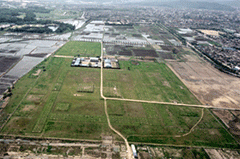 Panoramic view of the Hwangnyongsa Temple Complex
Panoramic view of the Hwangnyongsa Temple Complex
 Photograph of Decorative Tile
Photograph of Decorative Tile
International Academic Conference on the Restoration of Hwangnyongsa Temple
This conference brought together foreign and domestic experts to engage in public debates on historical site preservation, the significance of restoration, and the kinds of problems that may arise during restoration, to allow the development of a solid base for feasibility studies and restoration work on Hwangnyongsa Temple.
See details
Outline
We brought together foreign and domestic scholars and experts related to the promotion of restoration work at Hwangnyongsa Temple. Through wide-reaching debates concerning scientific and practical evidence of the methods and significance of restoration and the kinds of problems that can arise, we were able to take another look at the principles and issues of reconstruction. We also selected and announced a collective proposal developed through the results of this conference’s debates.
- Conference Dates : 28~29 April 2006 (Two Days)
- Conference Venue : Grand Ballroom, Hilton Hotel, Bomun Estate, Gyeongju
Participants
This conference brought together foreign and domestic experts to engage in public debates on historical site preservation, the significance of restoration, and the kinds of problems that may arise during restoration, to allow for the development of a solid base for feasibility studies and restoration work on the Hwangnyongsa Temple.
- Announced Participants : Foreign and Domestic Experts in Traditional Architecture, Cultural Relics and Related Fields.
- International Invitees : Experts in Cultural Relics from more than Four Countries, including Italy, the UK, Japan and China.
- Free Observation: Anyone with an interest in the subject.
Official Language
- Official Languages: Korean, English
- We provided simultaneous interpretation services during the meeting for invitees from non-English-speaking countries (4 countries).
Conference Topics
- Part I : “The Significance of Historical Site Restoration”
- Part II : “Practical Precedents for the Preservation and Restoration of Historical Sites.”
- Part III : “Feasibility Studies on the Restoration of Hwangnyongsa Temple”
- Part IV : “Issues and Review of Hwangnyongsa Temple Restoration”
Collective Suggestions
Hwangnyongsa Temple, whose construction was begun in 553 and completed in 645, is an important historical heritage site which demonstrates the essence of Silla Buddhist culture. The speakers and debaters that attended the Hwangnyongsa Temple International Academic Conference held in Gyeongju on the 28tth and 29th of April 2006 gave the following recommendations.
One : Value and Meaning
The restoration of Hwangnyongsa Temple is worth reviewing from the historical, educational and tourism perspectives, and will be a source of pride for both the people of Gyeongju and Korea as a whole.
Two : Direction of the Reconstruction Plan
The reconstruction of Hwangnyongsa Temple must be pursued in a direction that respects its inherent status as a cultural heritage.
Three : Necessity of Research
There needs to be a sufficient preliminary accumulation of in-depth studies in various fields for the reconstruction of Hwangnyongsa Temple to proceed smoothly.
Four : Methodology of Reconstruction
The reconstruction of Hwangnyongsa Temple must be cautiously promoted to meet with the special historical and cultural characteristics of Gyeongju while complying fully with international preservation standards.
Five : Consensus
Opinions must be widely collected on the reconstruction of Hwangnyongsa Temple, not just from related scholars and experts but also from the local community and civil groups.
Hwangnyongsa Temple Restoration and Maintenance Research
Our objective is to create a comprehensive restoration and maintenance plan for Hwangnyongsa Temple for the promotion of leading reconstruction projects in Gyeongju, of which the restoration of Hwangnyongsa Temple is a part. The comprehensive plan for the restoration and maintenance of Hwangnyongsa Temple will also present a new direction based on multiple fields for the restoration of ancient buildings. This is indispensible to the development of rational validity and public consensus on the promotion of restoration work. It is hoped that these various studies will increase the success of academic research in other related fields. We have been promoting preliminary restoration studies and basic studies in such fields as history, archaeology, art, Buddhism, urbanology, landscaping and historical architecture relating to historical work and the restoration of Hwangnyongsa Temple, and have published a 9-volume research series on Hwangnyongsa Temple. Our current work included the goal of creating a comprehensive restoration plan for Hwangnyongsa Temple by March 2012.
See details
Research Outcomes
Hwangnyongsa Temple Research Series 1
- Architectural Considerations on the Remains of Hwangnyongsa Temple
Hwangnyongsa Temple Research Series 2
- Basic Research on Technical Precedents for Restoration and Maintenance
Hwangnyongsa Temple Research Series 3
- Survey Studies on the Surface and Structural Systems of Ancient Buildings
Hwangnyongsa Temple Research Series 4
- The Present Situation and Research Tasks concerning Hwangnyongsa Temple
Hwangnyongsa Temple Research Series 5
- Basic Studies on the Main Building of Hwangnyongsa Temple
Hwangnyongsa Temple Research Series 6
- Basic Studies on the Restoration of Hwangnyongsa Temple
Hwangnyongsa Temple Research Series 7
- Interred Remains Unearthed from Hwangnyongsa Temple’s Central Section
Hwangnyongsa Temple Research Series 8
- Historical Research concerning the Restoration of Hwangnyongsa Temple
Hwangnyongsa Temple Research Series 9
- Research on New Directions for the Maintenance and Protection of Historical Vestiges in the Hwangnyongsa Temple Area
Master Plan for Maintenance of the Jeongnimsa Temple Site
The Jeongnimsa Temple Site (Historical Site) was the location of a Sabi-period Baekje Buddhist temple, now in downtown Buyeo. Jeongnimsa Temple was destroyed around the year 660 by the army of Tang General Su Ding Fang, and the area was known only as a Baekje-related historical site where a pagoda named Pyeongjaetap, or Su Ding Fang-tap, was located. The former existence of the temple was not discovered till 1917 when the name Jeongnimsa was found inscribed on a roof tile, identifying the temple as one that had closed down in the Goryeo Dynasty. The Five-story Stone Pagoda (National Treasure) is located above the central line south of the temple area, while Yeondongni Seated Stone Buddha (National Treasure) is situated in the hall area.
See details
Outline
Following the first excavation surveys of the Jeongnimsa Temple Area by Japanese scholars during the Japanese Imperial Period, the temple site was used as a Baekje pagoda park. As such, the full story of the temple complex was not revealed until the 1979-80 excavation survey by Chungnam University. The results of the survey led to the ‘earth-sheltering’ and maintenance of Jeongnimsa temple and to the erection of a protective canopy over the stone Buddha in the main hall area. Recently, the Jeongnimsa Temple Area Museum was opened to provide information and tourism materials about the historic features of the site. Maintenance work on the Jeongnimsa Temple Area began as part of a restoration and maintenance project with historical and cultural dimensions, and the National Research Institute of Cultural Heritage’s Gameunsa Temple Site, Gyeongju Restoration and Maintenance Team put the master plan for the site into effect in October 2005, and completed it in December 2006.
Plan Objective
- Reproduction of Baekje Architectural Culture
- Redevelopment of the Tourism Environment through Effective Maintenance
Plan Direction
- Effective Maintenance Plans for Redevelopment of the Tourism Environment
- Basic Planning for Social and Economic Feasibility Studies related to the Promotion of the Restoration and Maintenance Projects at the Jeongnimsa Temple Area
Basic Plan
- Area Reestablishment : Reconstruction and specialization of the Jeongnimsa Temple Area domain (restoration and maintenance) and the museum domain; domain planning for a practical application space between the Jeongnimsa Temple Area and the existing museum.
- Maintenance of the Tile Kiln Site : Construction of a Protective Canopy after Maintenance of the Baekje Tile Kiln Site
- Spatial Planning for Buyeo Residents : Expansion of Rest Facilities and Spaces for Commemorative Events
- Improvement of Amenities : Supplementation of Tourist Information Systems and Construction of Leisure and Information Facilities
- Improvement of Landscaping: Package Plans for Each Area and Planning for Landscaping
 Panoramic view of Buyeo Jeongnimsa Temple Area (South-North)
Panoramic view of Buyeo Jeongnimsa Temple Area (South-North)
 Panoramic view of Buyeo Jeongnimsa Temple Area (West-East)
Panoramic view of Buyeo Jeongnimsa Temple Area (West-East)
Basic Plan for Comprehensive Maintenance of the Gameunsa Temple Site, Gyeongju
The Gameunsa Temple Site, Gyeongju (Historic Site) was built as a patriotic temple during the United Silla period; the east and west three-story stone pagodas remain in good condition. It is a valuable cultural heritage asset where traces of the foundation stones and stereobates of the buildings have survived to the present day. Previous excavations of the Gameunsa Temple Site, Gyeongju include a 1959 survey by the National Museum of Korea and a 1979-80 survey by the National Research Institute of Cultural Heritage, reports on which where published in 1961 and 1997, respectively. The Gameunsa Temple Area cannot simply be left as an abandoned temple buried by the past but must be maintained as an active historic site that can connect with modern-day visitors.
The site is also in close proximity to the Underwater Tomb of King Munmu (Historic Site) in the East Sea, which is a symbol of that king’s passionate patriotism: As such, the sites may be used in conjunction to promote and encourage patriotism in local citizens and people from all over the country. This project, following the request by Gyeongju City in December 2006 for enterprises to act as proxies for the Master Plan for Comprehensive Maintenance of the Gameunsa Temple Site, Gyeongju, put the master plan into effect as part of the National Research Institute of Cultural Heritage: Gameunsa Temple Site, Gyeongju restoration and maintenance team, and brought it to completion in December 2007.
See details
Outline
Taking into consideration the fact that the Gameunsa Temple complex was constructed using the techniques of the United Silla period, we plan to use traditional materials and to source solutions from the period in order to generate a more meaningful understanding of such histo-rical sites for the public. We also plan to prepare a window for sharing information that can be used in the study of the culture and history of the entire region including the Gameunsa Temple region, and to use this to promote vivid and realistic historical education.
Plan Objective
Redevelopment of the Tourism Environment based on Effective Maintenance
Reproduction of Silla Architectural Culture and Its Use as a Window into Historical and Cultural Succession
Plan Direction
Compliance with the Principles of the Protection and Practical Use of Historic Artifacts
Maximum Restoration of Historic Remains to their Original Form
Planning for Maintenance Methods allowing for the Reversion of Historic Remains
Plan Contents
- Planning for Historical Site Restoration and Maintenance Methodology
- Redevelopment of Gameunsa Temple and Service Areas
- Provision of Observation Amenities through Information Centers and Sales Facilities
- Improvement of the Surrounding Landscape through the Demolition of Private Houses and Industrial Facilities
- Planning for Excavation Studies of Surrounding Areas Not Yet Excavated
- Planning for the Expansion of the Cultural Heritage Protection Area
- Construction of a Recreation Green Space in the Gameunsa Temple Site, Gyeongju
- Creation of a Project Promotion Plan
Research Results
| 1992 | Report on the Repair of Geungnakjeon Hall of Bongjeongsa Temple, Andong |
|---|---|
| 1998 | Report on the Repair of Palsangjeon Wooden Pagoda of Beopjusa Temple, Boeun |
| Reports 1, 2, 3 on the Survey Studies on the Stone Pagoda at Mireuksa Temple Site, Iksan | |
| 2004 | West Three-story Stone Pagodas at Gameunsa Temple Site, Gyeongju |
| 2006 | Report on the Master Plan for the Repair and Rehabilitation of Hwangnyongsa Temple |
| 2006 | Information Package for the International Symposium on the Restoration of Hwangnyongsa Temple |
| 2006 | Report on the Master Plan for the Maintenance of the Jeongnimsa Temple Area |
| 2009 | Information Package for the Symposium on the Silla Gameunsa Temple and Three-story Stone Pagoda |
| 2010 | Report on the Repair of the West Three-story Stone Pagodas at Gameunsa Temple Site, Gyeongju |
| 2010 | Report on the Repair and Overhaul of the East Three-story Stone Pagodas at Gameunsa Temple Site, Gyeongju |
| 2010 | Collection of materials on research concerning the restoration of Mireuksa Temple-I through IV |
| 2011 | Report on disassembly and survey of Stone Pagoda in the Mireuksa Temple Site, Iksan |
| 2011 | Repair and overhaul of Stone Pagoda at Mireuksa Temple Site, Iksan (a collection of materials presented at an international forum) |
| 2011 | Report on repair of Dabotap Pagoda at Bulguksa Temple, Gyeongju. |
| 2012 | Report on excavation and survey of the foundation of Stone Pagoda at Mireuksa Temple Site, Iksan |
| 2013 | Sarira Reliquary of the Stone Pagoda at Mireuksa Temple Site, Iksan |
| 2013 | Basic plan for restoration and maintenance of the fence of Hwangnyongsa Temple |
| 2013 | First in-depth research on the restoration of Hwangnyongsa Temple (Hwangnyongsa Temple Research Blue Paper 11) |


